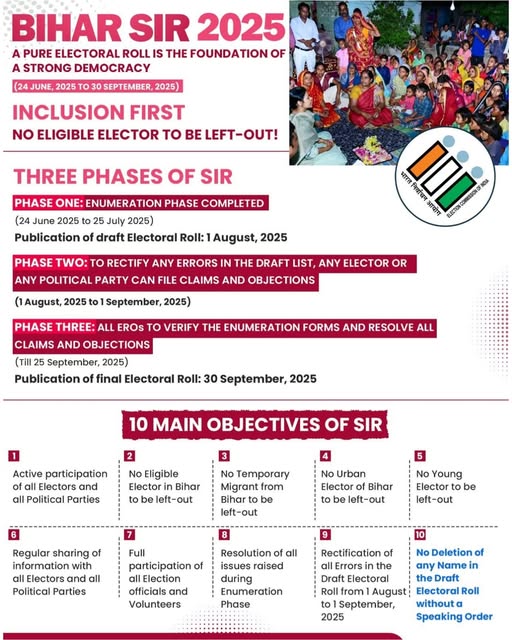Sami Ahmad, TwoCircles.net
Patna: Zaheeb Ajmal, a social activist in Phulwari Sharif, Patna, has been helping residents, particularly slum dwellers and other socially and economically disadvantaged groups, who are anxious about their names missing from the draft voter list after the recent Special Intensive Revision (SIR) of the electoral roll in Bihar. Until recently, he and his team could verify names within minutes. Now, the process has become slow and painstaking.
The reason, he explains, is a sudden change in policy by the Election Commission of India (ECI). “This is not possible now. Though the boothwise draft voter list is available on the ECI website, its PDF has been replaced with a scanned and unsearchable version. That forces anyone to go through the entire list manually, which may contain as many as 1,200 names,” he told TwoCircles.net
Earlier, using the searchable PDF format, Zaheeb’s team could simply enter a voter’s name or EPIC number, using a shortcut (Ctrl + F), and retrieve the result within seconds. Now, they have to scroll manually through dozens of pages, each packed with names, to locate a single entry.
“What was once a swift task has become an exercise in endurance,” he said.
This challenge is not unique to Zaheeb. Across Bihar, many organisations and volunteers who were helping citizens unfamiliar with digital processes are now struggling to assist them. The absence of a searchable format has made voter verification slow, laborious and frustrating.
Kamayani Swami, national secretary and state convenor of the Bharat Jodo Abhiyan, has been documenting the difficulties faced by marginalised communities during and after the SIR. “The draft roll, which is available on the ECI website as a PDF, cannot be searched,” she said and elaborated on the difficulty this presents.
“So, one ends up taking help from three different links before one can trudge through this PDF to find one’s name. This is not what most people are capable of doing, negotiating three web spaces to find one piece of data. In addition, at a macro level, this has made it very difficult for stakeholders to show with concrete examples the sham that the SIR has become,” she added.
Kamayani pointed out that parties, civil society groups and individual voters are all being handed fragmented information in difficult-to-analyse formats.
“Booth numbers have changed. So, finding one’s name is difficult to start with,” she highlighted.
At a recent Jan Sunwai (public hearing) on the SIR process in Patna, she shared her own example: “My booth has changed from 201 to 241 and the PDF of the draft roll is not searchable, so I had to scroll all 40 pages to find one name.”
Sarfaraz, the Bihar state secretary of the People’s Union for Civil Liberties (PUCL), also expressed concerns about the shift. According to him, the ECI’s decision to replace machine-readable draft rolls with scanned image files marks a serious setback for transparency and public oversight.
“The earlier digital lists allowed researchers, political parties and citizen groups to run quick and accurate searches, compare data and detect errors or omissions efficiently. By switching to non-searchable scanned images, the process has been reduced to manual and time-consuming checks. As a result, a large-scale and detailed analysis has almost become impossible,” he told TwoCircles.net.
Sarfaraz warned that this change would most affect those already at the margins (women, migrant workers and people living in under-resourced areas) many of whom are already at greater risk of being excluded from voter rolls.
“Without the ability to process data quickly, identifying and correcting such exclusions becomes far more difficult. It also limits the scope for independent audits and fact-checking at the booth and constituency levels, which are essential safeguards against wrongful disenfranchisement,” he said.
With state elections nearing, he stressed that accuracy and inclusivity in the electoral roll are essential. “Restricting access to machine-readable data at this stage undermines public confidence in the process and raises questions about institutional commitment to openness,” he said.
Sarfraz added that restoring digital access to the voter lists would be a simple but crucial step toward ensuring every eligible citizen can vote.
Kamayani agreed and alleged that the ECI appears to be making it harder for organisations and individuals to analyse voter data, especially those challenging the SIR process.
“At the level of political parties, while the first deletion lists were made available to the state representatives, for 16th July, the final deletion lists that were confirmed on 1st August were not made available at the state level,” she explained.
“The parties were then informed that these lists were being made available at the district level, and now the ECI has filed its counter affidavit, showing that the lists were provided at the booth level to the booth level agents (BLAs).”
According to her, this step-by-step decentralisation of information is not an accident. “This is being actively done so that stakeholders cannot simply download deletion lists, print and do physical verifications.”
Kamayani highlighted that in places where deletion lists were accessed, numerous irregularities came to light: newly eligible voters missing from the rolls, names of active voters, still residing in their home villages, deleted and even deceased voters continuing to appear despite families notifying the booth level officer (BLO).
“This clearly looks like the SIR is not an exercise at revision, but an exercise of deletion with little effort at inclusion,” she said.
“By giving lists in part and in not searchable and different formats, the ECI is trying to make verification of the SIR draft and deletion rolls difficult and near impossible,” she concluded.


